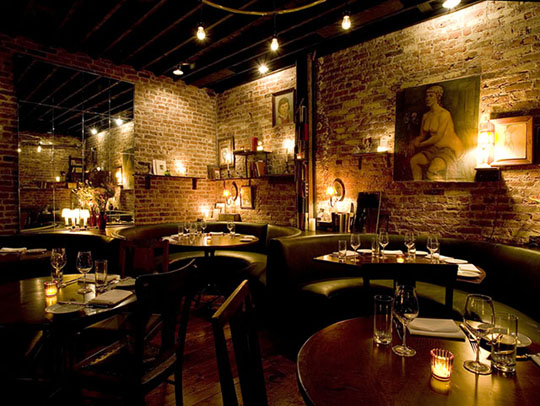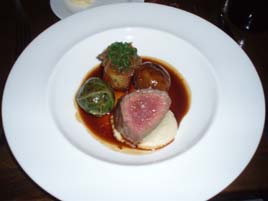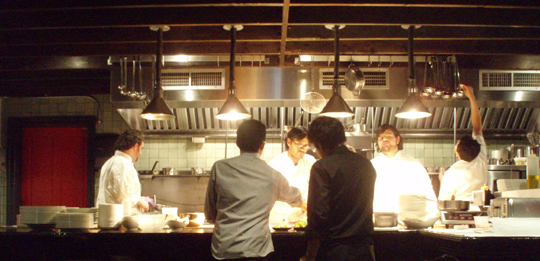
Akhtar Nawab (center) runs a tight ship at Elettaria
Note: Elettaria closed in August 2009, after the owners could not negotiate a lease extension.
*
Akhtar Nawab first came to prominence at Tom Colicchio’s Craftbar. He left in 2006 to go solo, but things didn’t quite go as planned. He was the originally announced chef at Allen & Delancey, but when the restaurant finally opened, Neil Ferguson was at the helm. Then he signed on at The E.U., a star-crossed restaurant if ever there was one.
 At Elettaria, Nawab is finally in control of his own destiny, along with partner Noel Cruz (Dani). Let’s hope that it’s a hit. Based on our meal there last night, it certainly deserves to be.
At Elettaria, Nawab is finally in control of his own destiny, along with partner Noel Cruz (Dani). Let’s hope that it’s a hit. Based on our meal there last night, it certainly deserves to be.
The name is the Latin word for cardamom, a spice often used in Indian cuisine. There are Indian accents all over the menu at Elettaria, but there are accents from a lot of places. Nawab is from Kentucky, and the cooking here could as well be called Modern American.
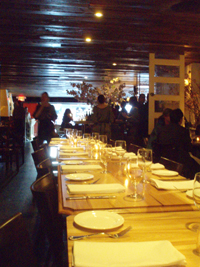 The interior design is from the same folks that did Allen & Delancey. You can see the resemblance, but their work is less successful here. For A&D’s charm, they’ve substituted a laundry list of clichés.
The interior design is from the same folks that did Allen & Delancey. You can see the resemblance, but their work is less successful here. For A&D’s charm, they’ve substituted a laundry list of clichés.
The bar takes up too much space. Dining tables are crammed too closely together. There’s a long row of them along the restaurant’s spine, and they’re just inches apart. We considered ourselves lucky to be there early, before the place filled up. There isn’t much space to manoever.
There’s a wide-open kitchen at the back of the restaurant. Nawab has it running smoothly. It’s a pleasure to watch. The space, most recently a men’s clothing store, was once a nightclub, and the kitchen is “on the very same spot where Jimi Hendrix reputedly plucked his guitar.”
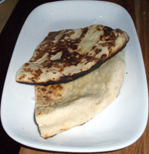

Bread service (left); White asparagus with foie gras (left)
Our dinner at Elettaria was one of those rare restaurant meals that actually improved as it went along. The bread service consisted of two slices of naan. For the appetizer course, we were both attracted to one of the recited specials: a serving of white asparagus with shaved foie gras.
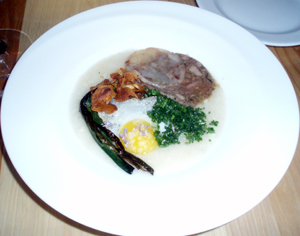
Pork, rice, quail egg
The asparagus, served chilled, had been over-cooked. The foie gras lacked the flavor punch it should have, and the few croutons offered were slightly soggy. At $20, this appetizer needed to be better.
The kitchen sent out a comped mid-course. It wasn’t on the printed menu, so I am guessing this is an item the chef is still tinkering with. He need tinker no longer. The highlights were two contrasting cuts of pork and a fried quail egg, resting in a slurry of rice. Nawab risks accusations of being derivative, with pork and fried eggs showing up on menus all over town, but this dish was much more of a hit than our original appetizer.
[Update: In his rave review for The Sun, Paul Adams described “an off-the-menu starter of lúgao ($12), Filipino rice porridge flavored with a succulent panoply of pig parts.” I am pretty sure that’s the mid-course item described above.]
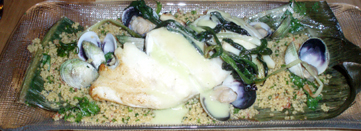
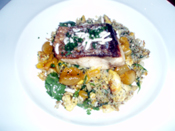
Red Snapper (left); Striped Bass (right)
We both chose fish for the main course: red snapper ($28) for me, striped bass ($22) for my girlfriend. The kitchen did well by both fish, which were tender, flavorful, and well complemented by the accompanying vegetables and cous cous. A bed of small clams that came with the red snapper seemed more decorative than anything else.
The wine list here is downright revelatory, with many great bottles under $50, along with an impressive list of cocktails, liqueurs, apéritifs, and so forth. A 2004 Cotes de Provence from Chateau de Roquefort was only $37.
Although our appetizer misfired, the cooking here is ambitious. Over time, we suspect that Akhtar Nawab will have many more successes than failures. The reasonable prices make the restaurant especially compelling. Elettaria is well worth a return visit.
Elettaria (33 W. 8th Street at MacDougal Street, Greenwich Village)
Food: **
Service: **
Ambiance: *½
Overall: **
 Tuesday, May 19, 2009 at 04:27PM
Tuesday, May 19, 2009 at 04:27PM  Actually, there are two hot dogs on Elettaria’s bar menu, either $2.50 or $4.50. The latter, which we ordered, resembles a hefty bratwurst sausage—house made, of course.
Actually, there are two hot dogs on Elettaria’s bar menu, either $2.50 or $4.50. The latter, which we ordered, resembles a hefty bratwurst sausage—house made, of course. The kitchen comped a crab cake (right), which wasn’t anywhere near as memorable as the bratwurst. An order of meatballs ($5), served on a skewer, had a mild curry flavor, but they weren’t tender enough.
The kitchen comped a crab cake (right), which wasn’t anywhere near as memorable as the bratwurst. An order of meatballs ($5), served on a skewer, had a mild curry flavor, but they weren’t tender enough.









